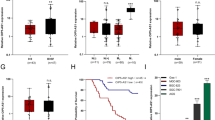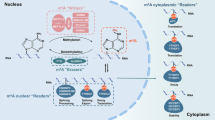Abstract
Jab1 (Jun activation domain-binding protein 1), also known as CSN5 (COP9 signalosome subunit 5), is frequently overexpressed in several cancer types. However, the biological functions and the molecular mechanisms of the Jab1 protein in human gliomas have not been investigated. In this study, we found that Jab1 protein was increasingly expressed in human glioma tissues comparing with normal brain tissues (Non-tumor). This suggested that Jab1 might be involved in the development of glioma. Thus, the role of Jab1 in glioma cell proliferation was investigated using Jab1 loss- and gain-of-function. The results showed that downregulation of Jab1 significantly inhibited glioma cell proliferation, while overexpression of Jab1 promoted it. Further investigation on molecular targets revealed that silencing of Jab1 obviously increased the p53 protein level thereby promoting the transcription of ubiquitin ligase Siah1 (Seven in absentia homolog 1), which aggravates the degradation of β-catenin. In contrast, overexpression of Jab1 had the opposite effect. Taken together, these findings suggest that Jab1 promotes glioma cell proliferation and increased expression of Jab1 in glioma patients may amplify β-catenin signaling to contribute to glioma cell proliferation.




Similar content being viewed by others
References
Meyer MA (2008) Malignant gliomas in adults. N Engl J Med 359(17):1850
Buonerba C et al (2011) A comprehensive outlook on intracerebral therapy of malignant gliomas. Crit Rev Oncol Hematol 80(1):54–68
Sherman JH et al (2011) Neurosurgery for brain tumors: update on recent technical advances. Curr Neurol Neurosci Rep 11(3):313–319
Fiorentino A et al (2013) [Adjuvant radiochemotherapy in the elderly affected by glioblastoma: single-institution experience and literature review]. Radiol Med 118(5):870–881
Levinson H et al (2004) Alpha V integrin prolongs collagenase production through Jun activation binding protein 1. Ann Plast Surg 53(2):155–161
Schutz AK et al (2012) Role of CSN5/JAB1 in Wnt/beta-catenin activation in colorectal cancer cells. FEBS Lett 586(11):1645–1651
Pan Y et al (2013) Suppression of Jab1/CSN5 induces radio- and chemo-sensitivity in nasopharyngeal carcinoma through changes to the DNA damage and repair pathways. Oncogene 32(22):2756–2766
Sang MM et al (2015) Suppression of CSN5 promotes the apoptosis of gastric cancer cells through regulating p53-related apoptotic pathways. Bioorg Med Chem Lett 25(15):2897–2901
Shackleford TJ, Claret FX (2010) JAB1/CSN5: a new player in cell cycle control and cancer. Cell Div 5:26
Sui L et al (2001) Jab1 expression is associated with inverse expression of p27(kip1) and poor prognosis in epithelial ovarian tumors. Clin Cancer Res 7(12):4130–4135
Hsu MC et al (2008) Overexpression of Jab1 in hepatocellular carcinoma and its inhibition by peroxisome proliferator-activated receptor{gamma} ligands in vitro and in vivo. Clin Cancer Res 14(13):4045–4052
Osoegawa A et al (2006) Overexpression of Jun activation domain-binding protein 1 in nonsmall cell lung cancer and its significance in p27 expression and clinical features. Cancer 107(1):154–161
Kouvaraki MA et al (2006) Potential role of Jun activation domain-binding protein 1 as a negative regulator of p27kip1 in pancreatic adenocarcinoma. Cancer Res 66(17):8581–8589
Kouvaraki MA et al (2003) Jun activation domain-binding protein 1 expression in breast cancer inversely correlates with the cell cycle inhibitor p27(Kip1). Cancer Res 63(11):2977–2981
Esteva FJ et al (2003) Jun activation domain binding protein 1 expression is associated with low p27(Kip1)levels in node-negative breast cancer. Clin Cancer Res 9(15):5652–5659
Pan Y et al (2012) Jab1/CSN5 negatively regulates p27 and plays a role in the pathogenesis of nasopharyngeal carcinoma. Cancer Res 72(7):1890–1900
Korbonits M et al (2002) Expression of phosphorylated p27(Kip1) protein and Jun activation domain-binding protein 1 in human pituitary tumors. J Clin Endocrinol Metab 87(6):2635–2643
Rassidakis GZ et al (2003) Expression of p27(Kip1) and c-Jun activation binding protein 1 are inversely correlated in systemic anaplastic large cell lymphoma. Clin Cancer Res 9(3):1121–1128
Shintani S et al (2003) Skp2 and Jab1 expression are associated with inverse expression of p27(KIP1) and poor prognosis in oral squamous cell carcinomas. Int Soc Cell Ther 65(4):355–362
Ivan D et al (2004) Expression of cell cycle inhibitor p27Kip1 and its inactivator Jab1 in melanocytic lesions. Mod Pathol 17(7):811–818
Jiang X et al (2010) The imprinted gene PEG3 inhibits Wnt signaling and regulates glioma growth. J Biol Chem 285(11):8472–8480
Jumpertz S et al (2014) The beta-catenin E3 ubiquitin ligase SIAH-1 is regulated by CSN5/JAB1 in CRC cells. Cell Signal 26(9):2051–2059
Fukushima T et al (2006) Critical function for SIP, a ubiquitin E3 ligase component of the beta-catenin degradation pathway, for thymocyte development and G1 checkpoint. Immunity 24(1):29–39
Shi H et al (2014) CacyBP/SIP protein is important for the proliferation of human glioma cells. IUBMB Life 66(4):286–291
Shi H et al (2015) Ubiquitin ligase Siah1 promotes the migration and invasion of human glioma cells by regulating HIF-1alpha signaling under hypoxia. Oncol Rep 33(3):1185–1190
Pan Y, Yang H, Claret FX (2014) Emerging roles of Jab1/CSN5 in DNA damage response, DNA repair, and cancer. Cancer Biol Ther 15(3):256–262
Tian L et al (2010) Essential roles of Jab1 in cell survival, spontaneous DNA damage and DNA repair. Oncogene 29(46):6125–6137
Zhang XC et al (2008) Roles for CSN5 in control of p53/MDM2 activities. J Cell Biochem 103(4):1219–1230
Zhang K et al (2012) Wnt/beta-catenin signaling in glioma. J Neuroimmune Pharmacol 7(4):740–749
Paul I et al (2013) Current understanding on EGFR and Wnt/beta-catenin signaling in glioma and their possible crosstalk. Genes Cancer 4(11–12):427–446
Latres E, Chiaur DS, Pagano M (1999) The human F box protein beta-Trcp associates with the Cul1/Skp1 complex and regulates the stability of beta-catenin. Oncogene 18(4):849–854
Oh W et al (2006) Jab1 induces the cytoplasmic localization and degradation of p53 in coordination with Hdm2. J Biol Chem 281(25):17457–17465
Tomoda K et al (2004) Multiple functions of Jab1 are required for early embryonic development and growth potential in mice. J Biol Chem 279(41):43013–43018
Acknowledgments
This work was supported by Jiangsu Planned Projects for Postdoctoral Research Funds (1302111B and 1402191C), the China Postdoctoral Science Foundation (2014M551662 and 2016T90507), the National Natural Science Foundation of China (81672490 and 81472345) and the Natural Science Foundation of Jiangsu Province of China (BK20151165).
Author information
Authors and Affiliations
Corresponding authors
Ethics declarations
Conflict of interest
The authors declare that they have no conflict of interest.
Additional information
Yufu Zhu and Zhichao Qiu have contributed equally to this work.
Electronic supplementary material
Below is the link to the electronic supplementary material.
11060_2016_2279_MOESM1_ESM.tif
Supplementary material 1 Figure 1: (A) Rescue experiment showed the Jab1 shRNA #2 was specific for Jab1. (B and C) EdU assay showed that the shRNA-resistant Jab1 (SR-GFP-Jab1) could abrogate the growth inhibition in the Jab1 shRNA-expressing cells. n.s: no significance, **P < 0.01. (TIF 25502 KB)
Rights and permissions
About this article
Cite this article
Zhu, Y., Qiu, Z., Zhang, X. et al. Jab1 promotes glioma cell proliferation by regulating Siah1/β-catenin pathway. J Neurooncol 131, 31–39 (2017). https://doi.org/10.1007/s11060-016-2279-6
Received:
Accepted:
Published:
Issue Date:
DOI: https://doi.org/10.1007/s11060-016-2279-6




